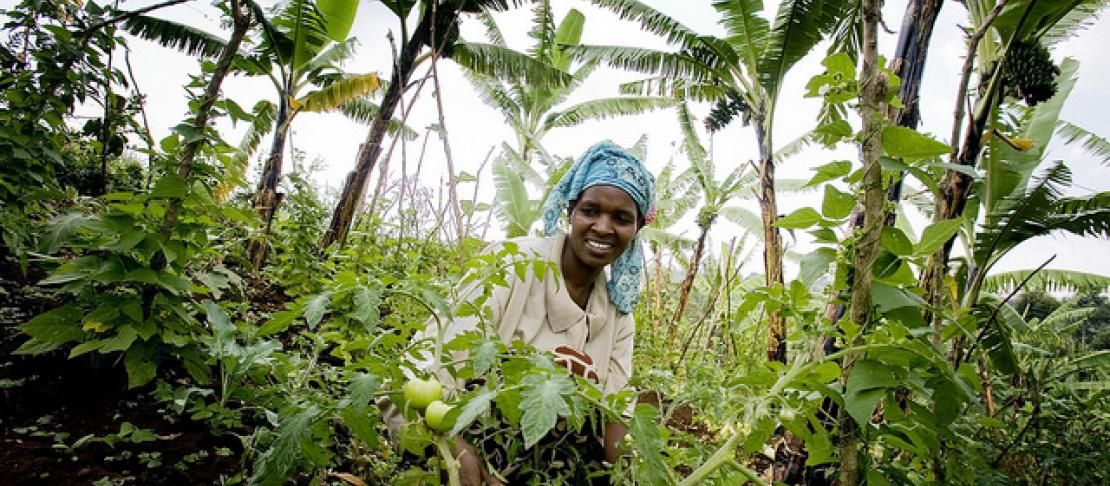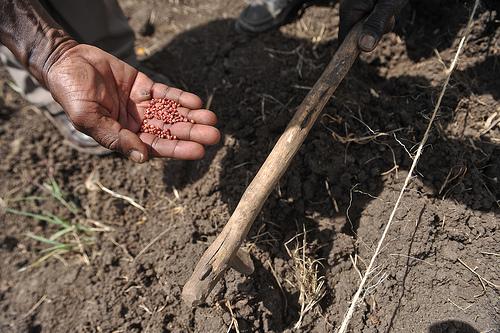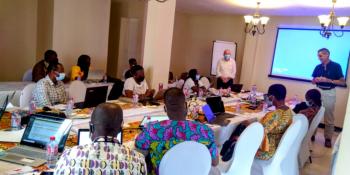Index-based insurance: a pathway out of poverty?

A recent workshop sought solutions to index insurance challenges.
If the rains fail, a farmer can lose everything. With even the chance of a bad year, investing in new crop varieties and technologies might be too risky. Year after year, she’s caught in the trap of low production.
Weather index-based insurance emerged at the beginning of the 21st century as a new tool to help change this story. The innovative insurance scheme aims to arm farmers against climate uncertainty where traditional crop insurance isn’t viable.
With this promise, researchers within the CGIAR agricultural research partnership want to find out how this tool can enable farmers to try out new seeds and production technologies that might help secure their food supply in a changing climate.
The CGIAR Research Programs on Climate Change, Agriculture and Food Security (CCAFS) and Policies, Institutions and Markets (PIM) brought together experts from across the CGIAR research partnership at the International Food Policy Research Institute (IFPRI) in Washington, DC 20-22 January, 2014 to tackle this question, and build new collaborations towards answering it.
A way to help farmers out of the poverty trap
To escape the trap of low production, farmers need access to better seeds and technologies, and loans to buy them. But where risk of crop failure from extremes like drought, flooding or pests is high, banks are not as willing to lend to smallholder farmers. Even if she can get a loan, a failed harvest driven by weather or climate extremes could leave a farmer with a debt she can’t repay. The risk of investment is simply too high, and the result is low productivity.
In a keynote address, Dr. Michael Carter of UC Davis showed how index insurance can help turn this story around. Dr. Carter’s premise is that when this risk is insured, banks may be more willing to give loans, and farmers can invest in new ways to increase their harvests.
“Simply removing some of that risk in the most direct and immediate way may actually encourage farmers to enhance the level of investment in their activities,” Dr. Carter said.
In bad years, families might not have to sell off assets like livestock to make ends meet, or cut back on meals. And in good years, they might have a better chance of increasing their harvests and saving up money over time.
Watch Michael Carter talk about index-based insurance and get his presentation “The Potential Impacts of Agricultural Insurance on Agricultural Development & Rural Livelihoods.”
But can insurance work beyond the pilot scale?
One of the biggest hurdles for index insurance is moving beyond small pilot projects. Pilot projects are carefully designed for a specific context, often where high quality data is available. But on a broader scale, gaps in weather data coverage in developing countries needed to create indices can increase basis risk – the possibility that insurance payouts don’t match with farmers’ losses. Farmers’ willingness to use new insurance products is also still a challenge, and building trust in these products is slow going.
Despite these challenges, a number of projects have grown to make payouts to thousands of farmers, and most without government subsidies. Dan Osgood from the International Research Institute for Climate and Society outlined the lessons we can learn from these projects, notably that index insurance is just one part of managing climate risk. Successful projects have brought farmers into index design, and used low cost methods of distributing insurance products.
Find out about these projects in his presentation:
Learning across borders
Even with these successes, farmers' willingness to start using various insurance products is still a challenge.
Experience in India has shown that basis risk – the possibility that payouts don’t match with farmers’ losses – remains a barrier to more farmers using insurance.
CCAFS has learned that increasing the density of weather stations, supplemented by remote sensing data, can create indices that are better matched with crop losses. Farmer satisfaction with insurance is also increased by involving them directly in keeping track of crop losses, and management of the insurance schemes.
India has the world’s largest index insurance program targeted to smallholder farmers, and new indices are being tested through community-managed programs in CCAFS South Asia’s Climate Smart Villages. In expanding insurance to new areas, CCAFS South Asia Regional Program Leader Pramod Aggarwal highlighted the opportunity for South-South collaboration in learning from these experiences:
What goes best with insurance?
Index insurance may work best when paired with other options for farmers such as credit, climate information services, or drought tolerant seeds. With insurance, both new and existing technologies to boost production might be within reach—but we need to know more.
As researchers mapped their projects in 19 countries, a picture of the collective strength of the CGIAR agricultural research partnership emerged. Index insurance relies on scientific muscle—from estimating harvests using satellite images to economic modelling and more—and on the ground knowledge about the policies and institutions that make insurance possible.
 index insurance might work best When paired with options for farmers such as drought tolerant seeds. Photo: K. Trautmann.
index insurance might work best When paired with options for farmers such as drought tolerant seeds. Photo: K. Trautmann.
CGIAR Research Programs and Centers have deep expertise in the different elements that make up index insurance, and long histories of working in countries and regions. Bringing together expertise in individual crops, livestock and production technologies with the science needed to make insurance work could be a pathway to insurance schemes that work better for farmers, and can move beyond the pilot level.
In one example, the International Livestock Research Institute’s (ILRI) Index Based Livestock Insurance project provides insurance for pastoralists based on satellite measurements of animal feed and predicted livestock mortality. Improving the precision of these measurements to better understand the nutritional value of forage is a key gap in the project, and could help researchers better predict the impact of drought on livestock. Building on expertise in the use of high resolution satellite data developed through projects like the International Rice Research Institute project Remote Sensing Based Information and Insurance for Crops in Emerging Economies (RIICE) is one path forward.
How using insurance affects farmers and other players in the value chain over time is still not well understood, but is critical to teasing out how sustainable it is as a strategy for poverty alleviation, and how effective in improving development. Participants agreed that economic impact evaluation of insurance schemes is a particular need.
Maximo Torero of PIM/IFPRI and Andrew Mude of ILRI discussed research opportunities in index insurance across CGIAR centers:
What’s next?
Index insurance has a long way to go before reaching its full potential in supporting farmers in a rapidly changing climate. Workshop discussions sparked new collaborations in project planning across CGIAR institutions and regions that hope to tackle these challenges, and highlighted some remaining questions: How do we bring private insurers into the game? Which technologies and finance options work best with insurance? How can insurance contracts be designed to better serve the needs of women and other vulnerable groups? Going forward, new collaborations are looking to these challenges, and to moving from hundreds to tens of thousands of farmers and beyond.
SCIENCE SEMINAR: Index based insurance arms farmers against uncertainty
Alexa Jay is a Communications Officer based with CCAFS Theme on Climate Risk Management.



